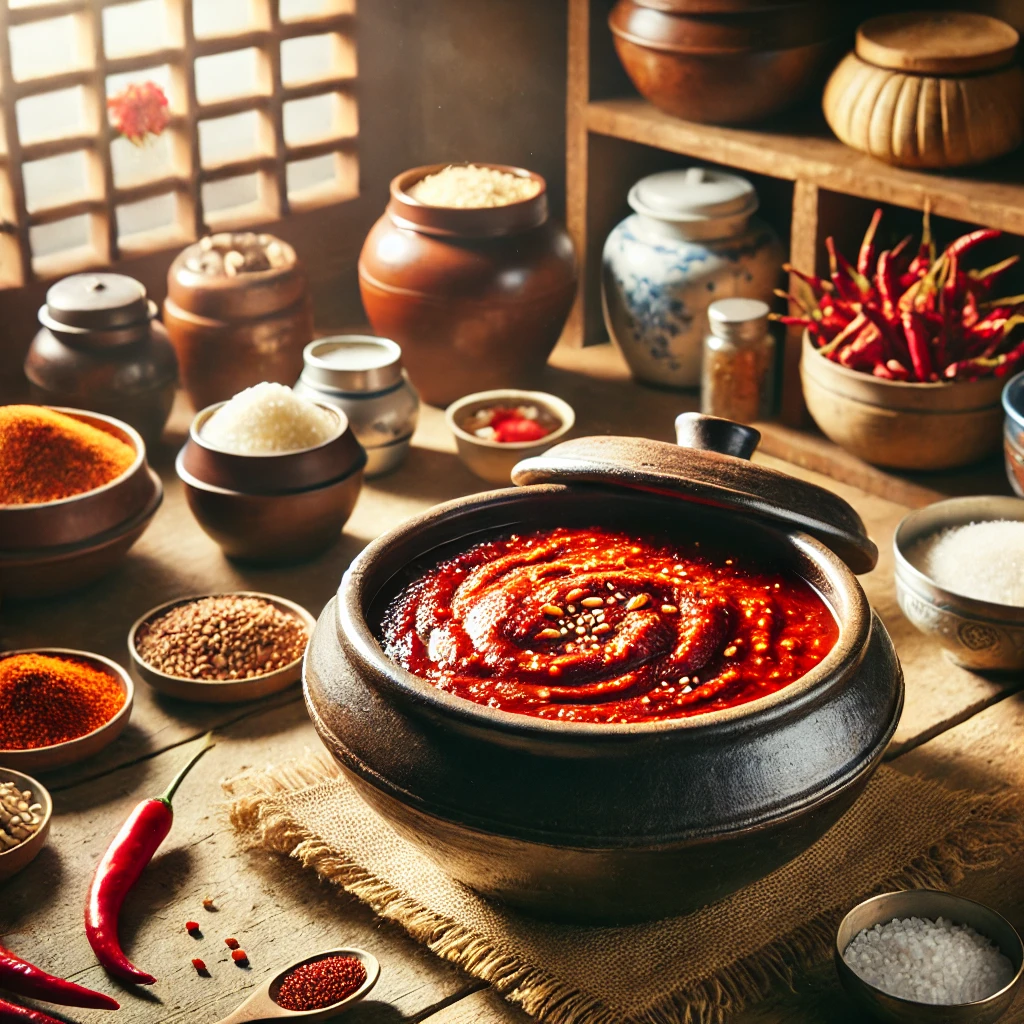Entertainment
What is That Concentrated Red Korean Sauce: Gochujang

If you’ve ever explored Korean cuisine, you’ve likely come across a thick, spicy red sauce that appears in many traditional dishes. This sauce is known as gochujang (고첨), one of the most distinctive and essential ingredients of Korean cooking. In this article, we will explore what gochujang is, its history, ingredients, how it is used in cooking, and the health benefits it provides.
What is Gochujang?
Gochujang is a fermented Korean sauce made from red chili powder (gochugaru), glutinous rice, fermented soybeans, and salt. Its consistency is thick, and its color is a deep red, almost ruby, which is as visually striking as its flavor is bold. It has a unique taste that combines spicy, sweet, salty, and umami elements. This combination provides a complexity of flavors that turns any dish into a special culinary experience.
The main characteristic of gochujang is the balance between the heat of the chili pepper and the sweetness of the glutinous rice. Unlike other hot sauces, it is not just fiery but also has a depth that comes from the fermentation process, contributing a well-rounded flavor that doesn’t completely dominate the dish but complements all of its elements.
The History and Cultural Importance of Gochujang
The history of gochujang dates back to the Joseon Dynasty (1392–1897), when the fermentation of chili peppers and other ingredients became common in Korea. The development of gochujang is closely tied to the arrival of chili peppers in Asia in the 16th century after being introduced by European traders. Since then, gochujang has become an essential part of Korean cuisine, used in both everyday dishes and special banquets.
Gochujang is much more than just an ingredient in Korea; it is part of the country’s cultural identity. Traditionally, the sauce was made at home by Korean families, who stored it in large earthenware pots called “onggi,” which were placed in sunny courtyards to facilitate the fermentation process. This artisanal production process helped maintain culinary traditions passed down from generation to generation.
Ingredients of Gochujang and Production Process
The main ingredients of gochujang include:
- Red Chili Powder (Gochugaru): The chili provides the characteristic spiciness and vibrant red color of the sauce.
- Glutinous Rice: Also known as sweet rice, it is fermented to give gochujang its sweetness and texture.
- Fermented Soybean Powder: Provides the umami base of the sauce, essential for its deep flavor.
- Salt: Used both for seasoning and to aid in preservation and fermentation.
The production process of gochujang involves mixing these ingredients, which are then placed in earthenware pots to ferment for months or even years. The fermentation is what gives gochujang its unique and complex flavor, as well as its probiotic characteristics that offer health benefits.
How to Use Gochujang in Cooking
Gochujang is extremely versatile and can be used in a variety of Korean dishes and even in Western recipes. Here are some common ways to use it:
1. Traditional Korean Dishes
- Bibimbap: One of the most well-known Korean dishes, bibimbap is a rice dish mixed with vegetables, meat, and egg. Gochujang is the essential sauce that ties all the flavors together.
- Tteokbokki: Spicy rice cakes cooked in a gochujang-based sauce. This dish is a popular street food in Korea.
- Jjigae (Stews): Various types of Korean stews use gochujang as a base, adding depth of flavor and a touch of spiciness.
2. Marinades and Sauces
Gochujang is excellent for use as a marinade for meats. It is commonly used in Korean barbecue, such as bulgogi or dak galbi (spicy chicken). The sauce, when mixed with honey, garlic, and sesame oil, creates a delicious marinade ideal for grilling.
3. Salad Dressings and Condiments
You can use gochujang as a base for salad dressings by mixing it with rice vinegar and a bit of honey. The result is a dressing with a spicy and sweet flavor, perfect for adding a special touch to vegetables.
Health Benefits of Gochujang
Besides being incredibly flavorful, gochujang also has several health benefits, especially due to its fermentation process. Some of the main benefits include:
1. Probiotic Properties
The fermentation process of gochujang generates beneficial microorganisms that help with gut health, contributing to healthy digestion and strengthening the immune system.
2. Weight Loss Aid
Gochujang has properties that can help with weight loss due to the capsaicin found in chili peppers. Capsaicin is known to boost metabolism and promote fat burning.
3. Blood Sugar Control
Studies suggest that gochujang may help regulate blood sugar levels, making it a potential ally for people trying to manage or prevent type 2 diabetes.
4. Reduction of Inflammation
Capsaicin also has anti-inflammatory properties, which can help reduce inflammation in the body, benefiting people who suffer from chronic inflammatory conditions.
Where to Buy and How to Store Gochujang
Nowadays, gochujang is widely available in Asian grocery stores and can also be found in larger supermarkets, especially in the international foods section. It usually comes in plastic tubs or containers, and it is important to store it in a cool, dry place or in the refrigerator after opening to ensure its preservation for longer.
How to Make Gochujang at Home
Making gochujang at home is not a quick task, but it can be extremely rewarding for those who love to cook. Here is a basic recipe for you to try:
Ingredients:
- 1 cup red chili powder (gochugaru)
- 1 cup glutinous rice powder
- 1/2 cup fermented soybean powder
- 1/4 cup sea salt
- 3/4 cup malt syrup or water
Instructions:
- Mix the glutinous rice powder with water and cook until it forms a smooth paste.
- Add the fermented soybean powder, red chili powder, and salt. Mix well.
- Transfer the mixture to an earthenware or glass jar and cover with a clean cloth.
- Let the sauce ferment in a sunny spot for at least 2 months, stirring occasionally.
This homemade fermentation process will give gochujang its complex and characteristic flavor.
Gochujang Substitutes
Although the flavor of gochujang is unique, there are some substitutes that can be used in a pinch. You can mix miso paste with red chili powder, honey, and a bit of vinegar to get a similar sauce, though it will not have the same complexity as true gochujang.
Popular Recipes with Gochujang to Try
If you want to explore using gochujang, here are some recipes worth trying:
1. Spicy Gochujang Chicken
Mix gochujang with minced garlic, honey, sesame oil, and soy sauce. Use this mixture to marinate chicken pieces and then grill until nicely caramelized. The result is juicy chicken with a spicy and slightly sweet flavor.
2. Gochujang Vegetable Stir-Fry
Use gochujang as the main sauce in a vegetable stir-fry, such as carrots, broccoli, and bell peppers. Add some soy sauce and sesame oil to complete the dish.
3. Korean Noodles with Gochujang (Bibim Guksu)
This is a simple and quick recipe: mix gochujang with rice vinegar, honey, and soy sauce, and use this mixture to dress cold noodles, adding vegetables like cucumber and carrot for freshness.
Final Considerations
Gochujang is a sauce that carries with it the history, traditions, and essence of Korean cuisine. With its unique flavor and versatility, it has the power to transform simple dishes into complex and memorable culinary experiences. Additionally, its health benefits are yet another reason to incorporate this ingredient into your cooking.
If you enjoy exploring new flavors and adding an exotic touch to your recipes, gochujang is a great starting point. Whether in marinades, soups, salads, or even in Western dishes, it will surely add a special touch to every meal. Enjoy and try gochujang today—you might be surprised by the richness this concentrated red sauce has to offer!
